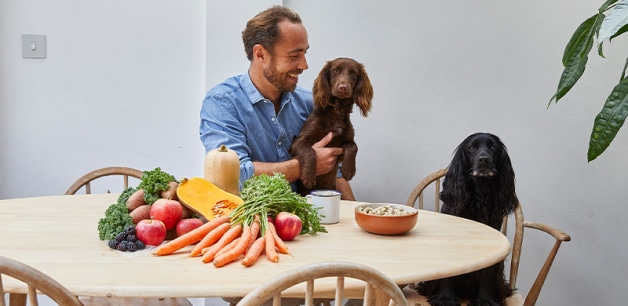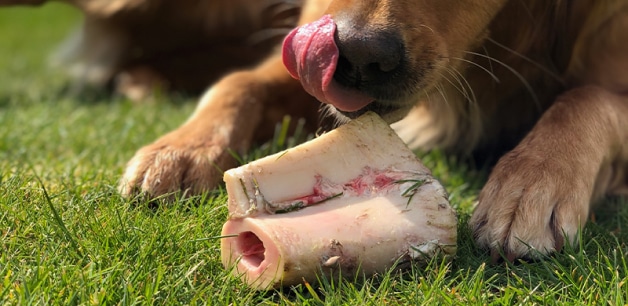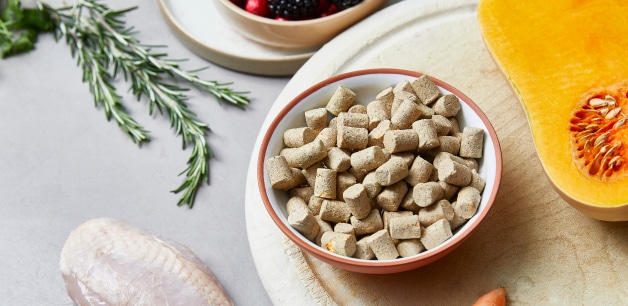A beginner’s guide on transitioning your dog to a raw diet
Being a responsible dog parent means investing in your dog’s health, and doing this through nutrition is key to their overall wellbeing. I believe the best thing you can do for your dog is feed them the best possible diet. For me, this means feeding a raw diet.
Dogs need meat, vegetables and fruit; and that’s what you get with a complete raw dog food. They don’t need cereals, grains and other fillers that we so often see in kibble diets.
Feeding your dog raw meals for the first time can be a little daunting though. This is why I wanted to put together a beginner’s guide on how to start feeding your dog a raw food diet. You won’t be disappointed with the results! Expect happier dogs, fewer trips to the vet, and a thriving pack, just like mine.
Why raw food?
After extensive research, I felt my dogs deserved more from the food they ate. Our switch to raw changed their lives for the better; both physically and mentally.
Within days of changing their food, my dogs had brighter eyes, shiner coats and their tummy troubles cleared up. They were also more eager for meal times, had sustained energy levels, and best of all – much healthier poo!
Feeding your dog raw food has a plethora of benefits and allows them to more easily absorb a variety of nutrients through their food. It offers a healthy balance of fats, carbohydrates, vitamins and minerals; each of which serve a purpose to support your dog’s health.
Crude fat, such as those found in chicken fat or oil, cover all fatty acids. These contain all of the amino acids and oils necessary for your dog’s skin, coat and joint health.
Healthy carbohydrates, such as sweet potatoes, are an excellent form of slow-release energy, giving your dog sustained energy levels.
Vitamins A, C and D, found in fruit and veg, provide antioxidants to support your dog’s immune system, muscle, bone and cognitive health.
You can truly see a happier and healthier dog when changing to raw food; I know I did with my pack.

Changing your dog’s diet
Many raw feeding advocates believe most dogs should be able to stomach an immediate switch to raw, since it is their natural diet. However, it is my belief that any new diet should be slowly introduced to your dogs. If dogs are transitioned onto new food too quickly, it could lead to stomach upset. To avoid this, a gradual change over 7-10 days is the best way to swap over your dog’s food.
Start off by adding small quantities of the new dog food to the current food. Increase the quantity until you have a full ratio of the new food. You could also choose to alternate meals between their original food and the new raw food.
If your dog has a particularly sensitive stomach, it’s best to make this process steady and gradual. You want to avoid further stomach upset or loose stools!
You might notice that your dog will start to turn their nose up at their old diet during this transition period. This is due to the new diet’s stronger smell and better taste. I noticed immediately that my dogs preferred their new raw diet; and I’m sure you will, too!

Fresh raw: making your own
My first experience with home raw feeding, though challenging, was also a lot of fun. However, it involves plenty of research and can be very time-consuming.
I found that maintaining a balanced and healthy diet was the trickiest part. It takes a lot of ingredients and care to produce a diet that contains the correct nutrients for your dog. Some pet parents I speak to worry they won’t get this right and can find it overwhelming.
Raw feeding, such as BARF (Biologically Appropriate Raw Foods), follows a golden ratio rule; but this can often be confusing. The ratios of what to do best can change, with more research coming out every year to support home raw feeding. Currently the best practice recommended is 64:8:8:20: meat; bones; offal; veg and fruit, respectively.
When incorporating fresh raw muscle meat into your dog’s diet, it’s best to stick to one type of protein. This is until your dog is fully accustomed to eating raw; after which it’s a good idea to offer multiple sources of protein. Beef, lamb, chicken and pork can be used and you can source mince too. I would recommend you research the best types of raw protein for your dog based on their age, breed, weight, and specific dietary needs.
Raw meaty bones (or RMBs) are a crucial component of a balanced homemade raw diet. It is best to find the most appropriate edible bones according to your dog’s size. I find that my cocker spaniels love goat knuckle bones; whereas Mabel, my golden retriever, is better suited to a tasty lamb rib.
My dogs absolutely love offal, or organ meats, such as kidney, liver and spleen. They play a very important role in raw food too. Secreting organs are a nutrient rich protein, containing many amino acids, vitamins, and minerals. Not only is it nutritionally rich, but offal often gets wasted as a byproduct, which is such a shame.
Raw fruit and vegetables have incredible antioxidant benefits, and they help to grow good gut bacteria. This helps maintain bowel regularity (that’s the healthy poo I was talking about!) However, it’s important to feed your dog fruit in moderation, as excess sugar can lead to tummy upsets or inflammation.
To create fresh food BARF diets from scratch yourself requires a lot of research, and also lots of passion. I would always advise you to speak with a vet or a qualified dog nutritionist to create a carefully balanced diet.

Frozen raw: buying complete food
For beginners, nutritionists recommend buying a complete raw food. This means it’s premade and already balanced with all the vitamins and minerals that your dog needs to thrive.
There are plenty of complete raw food brands available on the market, but I’d recommend checking your local community groups first. There are often excellent boutique raw food suppliers, who collaborate with your local butcher or grocer to source high quality ingredients. Not only will buying locally ensure you’re supporting these local businesses, but it will also reduce your carbon pawprint.
Most commercial raw food comes in frozen packets with daily serving suggestions for both puppies and adult dogs. You need to thaw and use the food within specific time frames. Because of this, ensure you have a freezer to store it in. Keep the raw food on a designated shelf in the refrigerator whilst thawing, so you know there’s no risk of contamination.

Freeze-dried raw: a new breed of pet food
I became frustrated with the inconveniences of home-prepping fresh raw diets, and the enormous amount of freezer space needed for frozen raw. This is why I looked for an alternative, which brought me to freeze-dried raw food. I started my journey to give my dogs the very best in dog nutrition, without the hassles of conventional raw food.
Freeze-dried raw dog food is a more convenient option to feeding your dog conventional raw, with minimal fuss or preparation. It’s made with human grade ingredients from all vital food groups; just like regular raw food.
The process of making freeze-dried raw dog food involves the extraction of all moisture in a vacuum chamber – with no exposure to heat. The removal of liquid lowers the risk of bacterial contamination, but crucially, the food remains microbiologically raw.
Freeze-dried raw food is extremely lightweight, making it much more convenient compared to hefty bags of dry food. Since it is room temperature stable, it doesn’t need to be kept refrigerated or frozen and requires no preparation. This is ideal for bringing your dog’s food with you anywhere, especially if you’re looking to take them on holiday! This is why I love it for my dogs: it provides all the goodness of raw, with the convenience of a kibble.
It’s the perfect solution for anyone unsure of how to make the switch to feeding their dog a raw diet.

In conclusion
The key points to remember when starting your dog on a raw diet:
Always introduce new food slowly so they can become accustomed to it.
Always refer to feeding guidelines for your dog’s weight and age.
Follow the appropriate storage instructions and maintain a high level of hygiene.
- Always maintain correct ratios and nutritional balance.
Following these steps will ensure that your dog loves their new food. You will start to see the positive changes to their health, just like I did with my own dogs! You won’t miss that old kibble diet once you start seeing a healthier, happier dog.
James & Ella x
